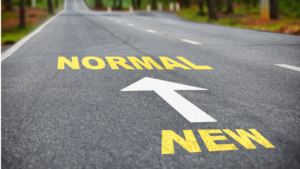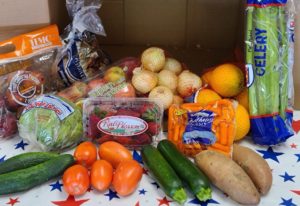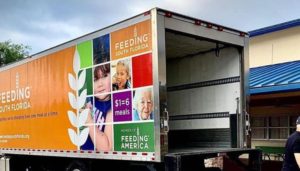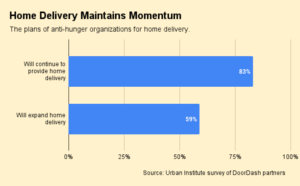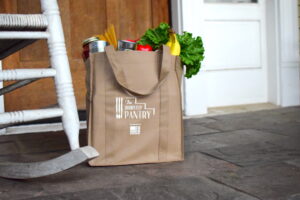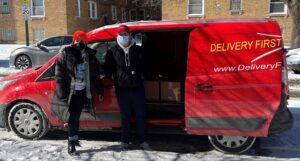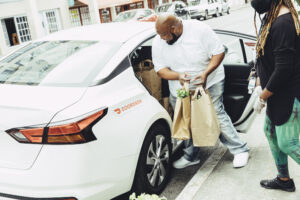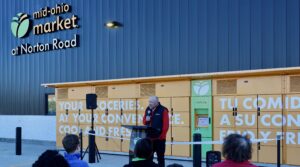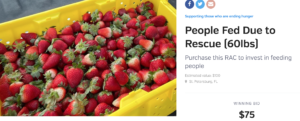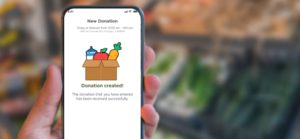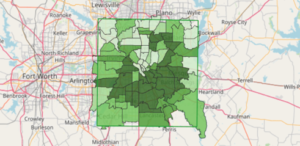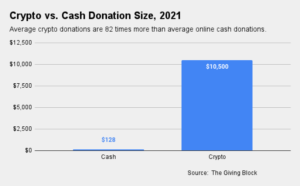As food banks seek to bring food straight to patrons’ homes, they are discovering that one of the most difficult aspects of home delivery is planning out the routes that drivers should take. Turns out there’s an app for that.
In California, both the Foodbank of Santa Barbara County and San Francisco-Marin Food Bank have significantly scaled up home delivery of groceries in response to intense demand from people seeking to shelter in place in response to the pandemic. Nationwide, the demand for meal deliveries has at least doubled at 80% of local Meals on Wheels programs since March 1.
Unlike the massive food distributions that have recently attracted headlines, home deliveries generally happen under the radar. Yet they also entail a lot of manual labor and complicated logistics. Route-planning software is helping food banks address some of those difficulties.

Foodbank of Santa Barbara County is getting assistance from Route4Me, an online service that helps plan out driving routes in the most effective way to reduce daily route planning and save on driving time, as well as gas money. San Francisco-Marin Food Bank is using a similar last-mile delivery service from Onfleet, which considers time, location, capacity, and traffic to plan out the most efficient routes.
“It’s critical,” said Lacey Baldiviez, Director of Community Programs and Education at Foodbank of Santa Barbara County of Route4Me. “Without the software, it would be a huge mess.”
Since mid-March, the number of people receiving home deliveries from Foodbank of Santa Barbara County has gone up four- or five-fold from normal numbers, Baldiviez said. Currently, about 8,000 seniors are getting food delivered to their homes twice a month. Delivery services go out every day of the week.
“Our seniors are our highest at risk, especially during the pandemic,” Baldiviez said. “We want to make sure they’re safe.”
Route4Me allows the food bank to direct drivers to seamlessly pick up food and deliver it to locations without any additional stress or planning. Route4Me “allowed us to start the program up quickly and help more people,” Baldiviez said.
At San Francisco-Marin Food Bank, the Onfleet software program has helped to jumpstart the food bank’s growing home delivery groceries (HDG) program.

The initiative had already been running prior to the pandemic, with volunteers delivering food to about 1,500 people. With over 275 pantries that work in conjunction with schools, faith-based, and community organizations, groceries are sent to partners that get volunteers to deliver. Each week, people receive about 25 pounds of fresh produce along with proteins and grains.
Now, the program has increased to include more than 11,000 people.
“When the COVID crisis hit, we wanted to grow our home delivery groceries,” said Andy Burns, Director of Participant Engagement. “We knew we wouldn’t be able to scale up like that without a routing software. This will be a huge step forward.”
Before using Onfleet, San Francisco-Marin Food Bank did everything on paper, with no order to the routing. Now Onfleet’s last-mile delivery software connects customers, drivers and dispatchers, allowing the food bank to deliver over 1,000 bags of groceries to seniors in need within the first week of using the product. By the second week, the number grew to over 6,000 meal deliveries. Now, the food bank is delivering over 2,000 bags a day.
“We’ve run into a lot of people that weren’t aware of our HDG program,” Burns said. “The word is out.”
A majority of delivery recipients for San Francisco-Marin Food Bank are over the age of 65. Others who qualify for the HDG program are those with underlying health issues, as well as people with disabilities. “We were concerned about them gathering at our pantries and for their health,” said Burns, who hopes to continue using Onfleet after the pandemic.
San Francisco-Marin Food Bank has a protocol in place to ensure the least amount of contact. It includes having volunteer drivers wearing masks and gloves, while also sanitizing between rides. Deliveries are placed at front doors and after the doorbell is rung, drivers step up to eight feet away to create a safe distance so that the recipient can safely acknowledge the groceries. People who package the groceries also maintain a safe social distance while wearing gloves and face masks.
Both Route4Me and Onfleet are currently offering their services for free to non-profits and other organizations providing mission-critical services, such as food and medical deliveries during the pandemic.
In the case of Route4Me, organizations register through the company’s website. If they disclose the field of work they do, Route4Me will validate and grant them access to the free enterprise edition package, which allows companies to put all stops in the system and discover driver locations through GPS. The service can be used on both a computer or smartphone.
Over 100 universities, food banks and medical organizations are taking advantage of Route4Me’s free offer, which would normally cost upwards of hundreds of dollars, depending upon the number of drivers using the service, according to George Shchegolev, Co-Founder and Vice President of Operations at Route4Me.
Customers are able to get up and running in less than two hours, according to Shchegolev. “When COVID started to unravel, we realized that government and federal agencies don’t have the capacity to supply as much as is necessary now,” Shchegolev said. “We just want to generally help them as long as we can.”
Onfleet, meanwhile, whose software is available in seven languages, is currently working on releasing a contactless signature feature to add to its texting services and routing optimization. Within five minutes, the company can have delivery services up and running.
“Everybody has a role and in some cases it’s to stay at home,” said Liz Hawkins Tahawi, Onfleet’s Director of Marketing. “This is a way we can contribute during the pandemic. Technology can help get food to more people during this time of insecurity.”
— Monica Sager
Monica Sager is a freelance writer from Clark University, studying psychology and journalism. Monica has previously been published in The Pottstown Mercury, The Week UK, and Worcester Telegram and Gazette. Read more of her previous work on her Twitter @MonicaSager3.
CAPTION ABOVE: San Francisco-Marin Food Bank uses route-planning software from Onfleet to coordinate its meal-delivery drivers.
Connect with Us:

